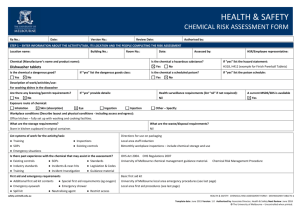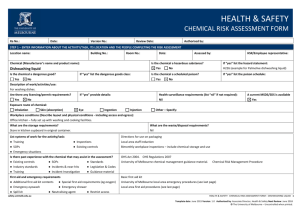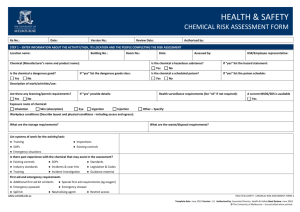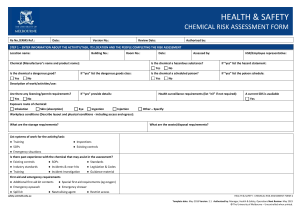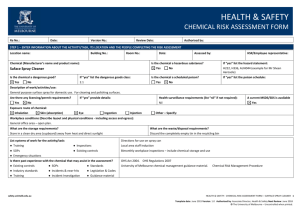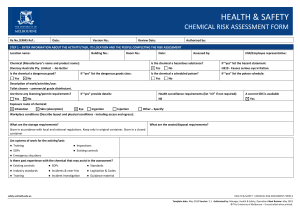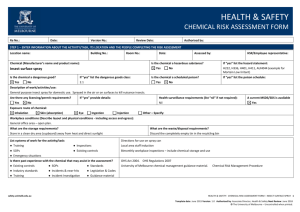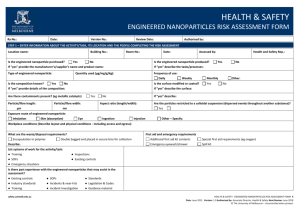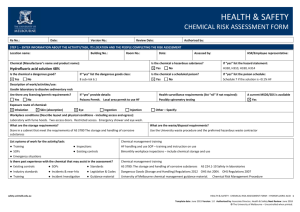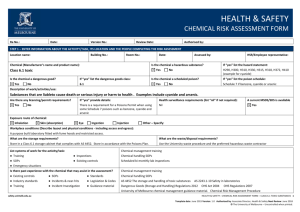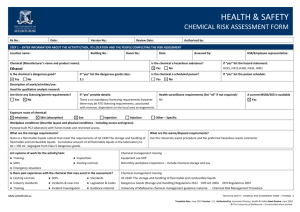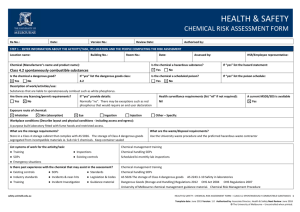Whiteboard Cleaner Risk Assessment - Safety
advertisement
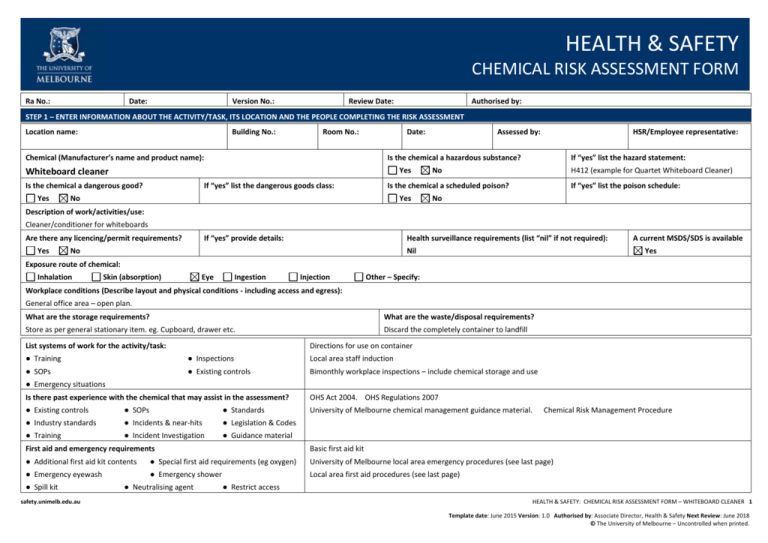
HEALTH & SAFETY CHEMICAL RISK ASSESSMENT FORM Ra No.: Date: Version No.: Review Date: Authorised by: STEP 1 – ENTER INFORMATION ABOUT THE ACTIVITY/TASK, ITS LOCATION AND THE PEOPLE COMPLETING THE RISK ASSESSMENT Location name: Building No.: Room No.: Chemical (Manufacturer’s name and product name): Date: Yes HSR/Employee representative: Is the chemical a hazardous substance? Yes Whiteboard cleaner Is the chemical a dangerous good? Assessed by: If “yes” list the dangerous goods class: If “yes” list the hazard statement: No H412 (example for Quartet Whiteboard Cleaner) Is the chemical a scheduled poison? No Yes If “yes” list the poison schedule: No Description of work/activities/use: Cleaner/conditioner for whiteboards Are there any licencing/permit requirements? Yes If “yes” provide details: Health surveillance requirements (list “nil” if not required): No Nil A current MSDS/SDS is available Yes Exposure route of chemical: Inhalation Skin (absorption) Eye Ingestion Injection Other – Specify: Workplace conditions (Describe layout and physical conditions - including access and egress): General office area – open plan. What are the storage requirements? What are the waste/disposal requirements? Store as per general stationary item. eg. Cupboard, drawer etc. Discard the completely container to landfill List systems of work for the activity/task: Directions for use on container ● Training ● Inspections Local area staff induction ● SOPs ● Existing controls Bimonthly workplace inspections – include chemical storage and use ● Emergency situations Is there past experience with the chemical that may assist in the assessment? OHS Act 2004. OHS Regulations 2007 ● Existing controls ● SOPs ● Standards University of Melbourne chemical management guidance material. ● Industry standards ● Incidents & near-hits ● Legislation & Codes ● Training ● Incident Investigation ● Guidance material Chemical Risk Management Procedure First aid and emergency requirements Basic first aid kit ● Additional first aid kit contents ● Special first aid requirements (eg oxygen) University of Melbourne local area emergency procedures (see last page) ● Emergency eyewash ● Emergency shower Local area first aid procedures (see last page) ● Spill kit safety.unimelb.edu.au ● Neutralising agent ● Restrict access HEALTH & SAFETY: CHEMICAL RISK ASSESSMENT FORM – WHITEBOARD CLEANER 1 Template date: June 2015 Version: 1.0 Authorised by: Associate Director, Health & Safety Next Review: June 2018 © The University of Melbourne – Uncontrolled when printed. STEP 2: SELECT A RISK RATING METHOD TWO VARIABLE RISK MATRIX THREE VARIABLE RISK CALCULATOR (1) Definitions of likelihood labels (1) Definitions of exposure variables Likelihood (Probability) Level Descriptor Description Exposure E Expected to occur Continuously or many times daily 10 6 A Almost certain The event will occur on an annual basis Once a year or more Frequently: Approximately once daily B Likely The event has occurred several times or more in your career Once every three years Occasionally: Once a week to once a month 3 Infrequently: Once a month to once a year 2 C Possible The event might occur once in your career Once every 10 years Rarely: Has been known to occur 1 D Unlikely The event does occur somewhere from time Once every 30 years to time Very rarely: Not known to have occurred 0.5 E Rare Heard of something like the event occurring elsewhere (2) Definitions of likelihood variables Once every 100 years (2) Definitions of consequence labels Severity level Consequences V Catastrophe One or more fatalities and/or severe irreversible disability to one or more people IV Major Extensive injury or impairment to one or more persons III Moderate Short term disability to one or more persons II Insignificant Medical treatment and/or lost injury time <2 weeks I Negligible First aid treatment or no treatment required Likelihood L Almost certain: The most likely outcome if the event occurs 10 Likely: Not unusual, perhaps 50-50 chance 6 Unusual but possible: (e.g. 1 in 10) 3 Remotely possible: A possible coincidence (e.g. 1 in 100) 1 Conceivable: Has never happened in years of exposure, but possible (eg 1 in 1,000) 0.5 Practically impossible: Not to knowledge ever happened anywhere (e.g. 1 in 10,000) 0. 1 (3) Definitions of consequence variables (3) Risk rating matrix Likelihood Consequence label label I II III IV V A Medium High High Very high Very high B Medium Medium High High Very high C Low Medium High High High D Low Low Medium Medium High E Low Low Medium Medium High Consequences C Catastrophe: Multiple fatalities 100 Disaster: Fatality 50 Very serious: Permanent disability/ill health 25 Serious: Non-permanent injury or ill health 15 Important: Medical attention needed 5 Noticeable: Minor cuts and bruises or sickness 1 (4) Risk score calculator Risk Score = E x L x C safety.unimelb.edu.au Risk score Risk rating > 600 Very high 300 - 599 High 90 - 299 Medium < 90 Low HEALTH & SAFETY: CHEMICAL RISK ASSESSMENT FORM – WHITEBOARD CLEANER 2 Template date: June 2015 Version: 1.0 Authorised by: Associate Director, Health & Safety Next Review: June 2018 © The University of Melbourne – Uncontrolled when printed. STEP 3 – REVIEW CHEMICAL PROCESS For each stage of the chemical risk assessment: Hierarchy of Control (Control Type) Review the prompts/examples for each route of exposure for each category; El – Elimination Determine and record a raw risk score by referencing the two variable risk matrix or the three variable risk calculator; S – Substitution In the comments box, describe the route of exposure and any other information (if applicable); En – Engineering Specify the risk control type for each current or proposed risk control; Sh – Shielding Provide a control description for each current or proposed risk control; A – Administrative T – Training Where proposed risk control(s) have been identified complete a Health & Safety Action Plan; M – Monitoring Determine the residual risk score referencing the same two variable risk matrix or three variable risk calculator used to determine the raw risk score. P – PPE Category Raw Risk Score Storage ● Skin (absorption ● Eye ● Ingestion ● Injection ● Other Handling In – Inspection H – Health Monitoring For information devising appropriate controls, refer to: Guide to Chemical Risk Hierarchy of Control. Control Type Control Description (Current and Proposed) Residual Risk Score A Use as per instructions Low Nil ● Inhalation ● Skin (absorption ● Eye ● Ingestion ● Injection ● Other Decanting/Mixing Nil ● Inhalation ● Skin (absorption ● Eye ● Ingestion ● Injection ● Other Applying/Using 1 x 1 x 50 ● Skin (absorption = 50 ● Eye ● Ingestion Low ● Injection ● Other Spill/Leak Mild discomfort to eyes Do not spray near eyes Nil ● Inhalation ● Skin (absorption ● Eye ● Ingestion ● Injection ● Other safety.unimelb.edu.au G – Guarding Nil ● Inhalation ● Inhalation Comments (when/where the exposure is present) Is – Isolation HEALTH & SAFETY: CHEMICAL RISK ASSESSMENT FORM – WHITEBOARD CLEANER 3 Template date: June 2015 Version: 1.0 Authorised by: Associate Director, Health & Safety Next Review: June 2018 © The University of Melbourne – Uncontrolled when printed. Category Raw Risk Score Comments (when/where the exposure is present) Control Type Disposal Control Description (Current and Proposed) Residual Risk Score Nil ● Inhalation ● Skin (absorption ● Eye ● Ingestion ● Injection ● Other STEP 4 – IMPLEMENTATION AND CONSULTATION PROCESS Determine the person responsible for reviewing and implementing the risk assessment including the identified controls. Ensure a Health & Safety Action Plan has been completed, reviewed and signed off where proposed controls have been identified. Obtain the authorisation of the management representative. Ensure the HSR (if applicable) has been consulted. Ensure the employees undertaking the activity have been consulted. Record below the names of the persons consulted. Management representative HSR/Employee representative Employee(s) Employee(s) Employee(s) Employee(s) Person Responsible for implementation or escalation Extra writing room - use this page to enter extended comments or descriptions Review: Review risk assessment every 3 years. Review employee chemical procedures during workplace inspections. Review risk assessment where there is an incident with the chemical or new information becomes available. Review risk assessment when the MSDS is updated/reissued. Emergency and First Aid procedures Ensure that general first aid procedures and resources are in place and available. First aid risk assessment and procedures that take into account the risks associated with the chemical and possible adverse outcomes. University of Melbourne and local area emergency procedures. PPE Nil To eliminate injuries always use the chemical in accordance with the manufacturer’s instructions and for its intended purpose only. For use in conjunction with the OHS risk management procedure and the Chemical risk management procedure. For further information, refer to http://safety.unimelb.edu.au/tools/risk/ or contact your Local Health & Safety contact. safety.unimelb.edu.au HEALTH & SAFETY: CHEMICAL RISK ASSESSMENT FORM – WHITEBOARD CLEANER 4 Template date: June 2015 Version: 1.0 Authorised by: Associate Director, Health & Safety Next Review: June 2018 © The University of Melbourne – Uncontrolled when printed.
